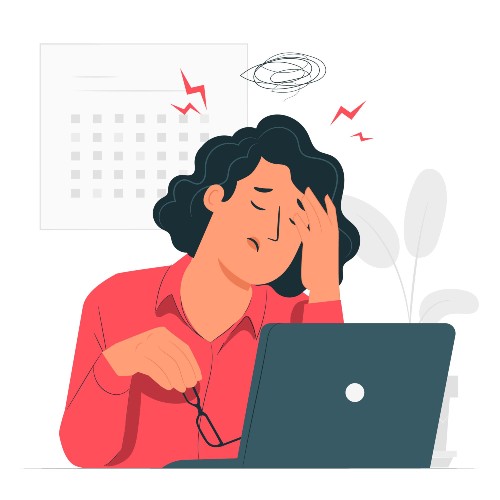
The B2B selling process can be complex and challenging for both buyers and B2B sellers. As a seller, identifying customer pain points and leveraging them is one of the best ways to boost sales, and it can be thought of as both an example of growth and conversion marketing.
Sellers can have their pain points, too. Understanding these as part of the B2B process can make it easier for both buyer and seller throughout the customer journey. Also, having a good understanding of the most common B2B pain points can make life much easier for a seller. You can address these directly as part of your sales funnel, leading to a far greater conversion rate and tackling buyer’s anxiety simultaneously.
B2B Sellers and Understanding Customer Pain Points
Customer pain points are issues that your customers frequently experience throughout the customer journey. If you know how to address these, you can solve them and provide your customers with a better experience. In turn, you can experience better sales and growth as a result.
When a customer purchases something, they do so as a result of their pain points. Generally, they consider how much they are willing to pay in order to resolve said pain points. These pain points can vary considerably from person to person and industry to industry. It’s also important to note that B2B buyers’ pain points are very different between the general public and consumer and those that are common within B2B sales.
Tackling B2B buyers’ pain points isn’t easy, but it’s crucial if you want to drive up your sales. It’s not enough to identify common pain points. You also need to be able to demonstrate how you can resolve them for a customer. Before doing so, you also need to be able to show the customer that you are reliable and that they can trust you to address their pain points.
There are certain categories of pain points, and these are the cause of most B2B buyers’ dissatisfaction. If your services or products as a seller address these, then you can be fairly confident that customers are going to be attracted to what you have to offer them.
Generate better leads to grow your sales
Discover new strategies to unlocking a flood of high-quality leads from your website.

A Guide: How to Identify Customer Pain Points
If you’re unsure of the common pain points that your customers have, you might want to take the time to find out what they are. Identifying your customers’ common pain points is often as simple as collecting some basic information from them or asking them some questions.
Within B2B sales, there are specific pain points that buyers tend to experience. Address these, and you should experience impressive conversions and growth. Tackling pain points within B2B is often simpler than it is when selling to the general public because the common pain points are more predictable and usually the same within a specific industry.
As such, if your customers are B2B buyers within a particular industry, it shouldn’t be difficult for you to notice patterns from buyer to buyer. You should be able to identify the most common pain points with some research and then modify your selling strategy where appropriate to tackle these before they become an issue. Present yourself as the solution to your buyers’ pain points and retaining them should be easy.
Firstly, you should ask your customers why they have left their previous vendor. Whatever their reasons are, you should ensure to offer an alternative as their new seller. Buyers can often identify poor practice or management from their vendor, and this affects their operations, too.
You should also ask your buyer how long they were with their previous vendor. This might give you an indication of how reliable the prior vendor was. You may also be able to identify trends with a particular vendor. For example, if you discuss the same vendor with several buyers, then it’s very likely that that vendor has been providing poor service. By offering a better alternative to vendors, you can often leverage the dissatisfactory service of your competitors to your own advantage.
Finally, and perhaps most importantly, you should ask your buyers about the aspects of their business that were impacted by the poor performance of their previous vendor. There may be a specific department that has struggled as a result, or the impact might be generalized across their entire operations. By identifying how the previous vendor impacted your buyer, you can tailor your service for them to avoid the same thing occurring.
Even B2B sellers have pain points! If your customer is a seller, then you should also discuss their pain points or negative experiences with them. Understanding how to identify and address customers’ pain points applies to all kinds of customers, even the ones you might not generally work with.

Some Common Customer Pain Points Examples
While best practice is to ask every buyer about their previous vendor to truly understand their pain points, you can often find that there are some fairly common pain points that are frequently experienced by B2B buyers. Tackling these allows you to provide a great service and ensure good customer retention without needing to spend great lengths of time discussing the individual pain points of each buyer directly.
Customer Support Pain Points
Many customers feel unsupported or lost during the purchasing process. This is a common pain point, and it might be enough to dissuade customers from financially committing to a service or product. Giving customers a personalized and supportive user experience is crucial to ensure good conversions throughout the sales process.
It’s important to have responsive customer support, too. If a customer or B2B buyer feels that customer service isn’t quick enough to respond or doesn’t provide them with enough information, they may take their business elsewhere. This is only natural, so preventing this by providing excellent customer service is a must for B2B sellers.
Productivity Pain Points
This may be one of the most common customer pain point examples within B2B. Since your customers are also small business owners, many of their pain points revolve around how their vendors negatively impact their operations. Their previous vendor may have been unreliable or provided poor service, for example. This can prevent your B2B buyer from being able to serve their customers in the way they would like.
Another common kind of productivity pain point is related to information management and products. Many B2B buyers work in hospitality and may use a number of IT systems to track their transactions and sales. They may even keep track of this information by hand! This is very inefficient and can be confusing.
Tackling these pain points may involve helping buyers improve their own internal performance and efficiency. This can be as a result of your own product or service or how your services impact your buyer. Tackling productivity pain points can be tricky, as they can vary considerably from industry to industry. However, it’s worthwhile.
Financial Pain Points
Another very common example of B2B buyer pain points is financial pain points. Simply put, your buyers may be spending too much money with their current vendor. Whether or not they perceive it this way depends on the quality of the service they receive and how profitable their own operations are. Still, it’s very common for smaller businesses within B2B to feel a considerable amount of financial pressure, and this may cause them to change vendors.
Working with Too Many Vendors
If your buyer is working with too many vendors, this can be a pain point in and of itself. Your buyer is unlikely to want to work with several vendors if they could reduce their dealings. By operating as a seller within a particular industry that provides a range of relevant services, you can alleviate a very common pain point for B2B buyers.
This might be true of their supply chain or their support providers. Whatever the case may be, it can feel overwhelming to work with several vendors for small business owners. Many buyers would welcome the opportunity to reduce their transactions to a single vendor that can provide them with both the services and products they need to operate.
Inefficient Operations
Your buyer may feel that their operations aren’t working as well as they would like. There might be one element of the business that is limiting profits or growth. By offering a simple solution (a better website, for example), you can change the company’s trajectory altogether.
Understanding customer pain points is essential for a B2B seller. By doing so, you can leverage the most common problems for potential customers and clients and present yourself as the solution. This is a fantastic way to boost growth and conversion, and it generally becomes easier as you adjust to working within a specific industry or niche.
Discussing pain points with your buyers is an essential part of understanding where they originate from, but it’s worth it. By doing so, you can set yourself apart from your competitors and often build up a great reputation amongst current and future B2B buyers in the process.
Understand your customer journey analytics
See how your users behave, find drop-offs, and receive actionable insights with AI.









